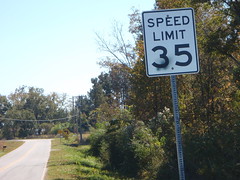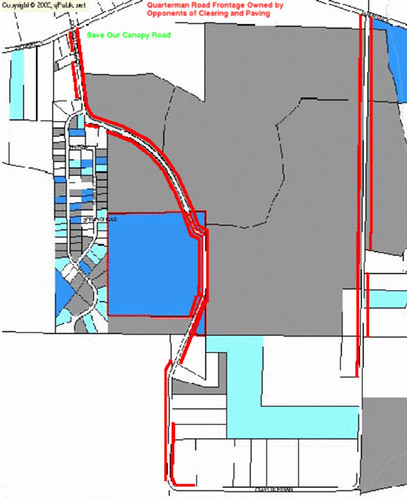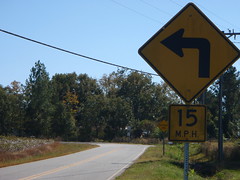 Even the already-paved part of Quarterman Road currently has a posted
speed limit of 35 MPH (shown at right). That’s the part the subdivision uses to go to work.
I have never heard anyone complain that speed limit is too low. Why, then,
would anyone need a faster speed limit on the rest of Quarterman Road,
which has less traffic?
Even the already-paved part of Quarterman Road currently has a posted
speed limit of 35 MPH (shown at right). That’s the part the subdivision uses to go to work.
I have never heard anyone complain that speed limit is too low. Why, then,
would anyone need a faster speed limit on the rest of Quarterman Road,
which has less traffic?
As mentioned in the previous post, I understand that county staff and commissioners are concerned about their certifications, liability, and even, as we heard at the public commission meeting, about getting telephone calls in the night. Here is evidence that turning Quarterman Road into a wider, faster, collector road would not reduce any of those risks to county staff or commissioners, rather, by decreasing the safety of the road and its residents, such changes would increase risks to staff and commissioners.
First note that AASHTO itself carefully distinguishes residential neighborhoods from highways:
When it comes to residential streets, narrower streets are better. Narrow streets slow traffic by increasing drivers’ perception of impediments to motion. If a driver perceives more obstructions, he/she is more likely to drive at slowers peeds to avoid potential conflicts. The American Association of State Highway Transportation Officials (AASHTO) asserts in, A Policy on Geometric Design of Highways and Streets: 2001, that residential streets are typically associated with short trips and are commonly used as a means of accessing property, so there is no need for high-speed travel.There is more in that essay; I recommend it to anyone interested in this subject, especially anyone whose responsibility includes road safety.…
Not only do excessively wide residential streets contribute to the number of accidents, they also add to the severity of accidents. Wide residential streets encourage speeding and in doing so, increase the potential severity of accidents. According to an article by John Anderson entitled, “Framing the Debate on Stre ets and Public Safety” (New Urban News, July/August 2000): “…wide streets encourage speeding and increase the risk of traffic accident injuries and fatalities.”
 Also note that no county staff or commissioners live on Quarterman Road.
I do, and I plan to live here until I die, as do most of the people who
opposed paving the road in the first place. The map on the right
shows in red the 2/3 of the road frontage owned
by opponents of paving, which my brother David sent to the commission
before their public meeting. Although the commission decided to pave the road against the
wishes of a majority of the households on the road, many of us still
have concerns about related issues, such as road width, curves, and
speed limit.
Also note that no county staff or commissioners live on Quarterman Road.
I do, and I plan to live here until I die, as do most of the people who
opposed paving the road in the first place. The map on the right
shows in red the 2/3 of the road frontage owned
by opponents of paving, which my brother David sent to the commission
before their public meeting. Although the commission decided to pave the road against the
wishes of a majority of the households on the road, many of us still
have concerns about related issues, such as road width, curves, and
speed limit.
On the west side, there is already a sharp curve with a 15 MPH advisory
speed limit, shown on the right.
It would make sense to put the same advisory in front of the canopy parts of the road.
And there is another sharp 90 degree bend at the southwest corner of the road.
What would be the point of setting the speed limit up to 45MPH only to
set it back down repeatedly?

On the east side, Quarterman Road has a mile-long straight stretch, which by paving and widening the county now proposes to turn into a mile-long speedway, right past my front gate. I do not want to have to be concerned about my wife’s safety as she turns into 70 MPH traffic when we are 90 years old. I do not want my sister-in-law to risk being run over by speeders whenever she bicycles on the road. I do not want the neighboring school children to be hit, nor the teenagers visiting each other. You heard Tuesday that Abigail and Lauro Barzallo plan to have children; I do not want their future babies to be run over in their stroller. I don’t want David Buckholts’ annoying dog to become road kill. I do not want the retirees on the road, some of them veterans, to risk life and limb whenever they go to the grocery store. I don’t even want to be run over on my tractor.
Brooks County just dropped the speed limit on Troupeville Road from 55 MPH to 45 MPH. I’m told they did this because more residents had moved in on the road, and people were pulling out into traffic. So it is possible to lower a speed limit below design speed. I’m told this was noted in the Quitman Free Press of 12 November. I do not have a copy, but I’m sure county staff can obtain one, or just ask neighboring Brooks County directly.
Many of the smaller lots visible on the road frontage map have become inhabited since the right of way was obtained by the county. For example, the Board of Assessors’ online real estate search shows the house on the southeast corner as being built in 1996, well after 1991. The five five-acre lots on the west side appear to have all been originally split out in 1996.
Thus the residential population of Quarterman Road has increased since the right of way was obtained; the right of way that determined the old road design (the design dating back to at least 2001 that the county still plans to use to pave Quarterman Road). Not just the total population: the number of school age children has increased even more. Thus Quarterman Road is in a similar situation to Troupeville Road, and its speed limit needs to be set lower than the design speed of the old road design.
Regarding that mile long straight stretch, it is my understanding that for the sheriff to use radar to enforce any speed limit, the limit must first be certified by GDOT and the state patrol. And that the first thing the state will do will be to check current actual traffic speeds on the road. If Quarterman Road is paved according to the old design, it is very likely people will be going very fast on that mile-long straight stretch, and the state will thus be reluctant to certify a speed limit lower than the design speed.
The best solution would be to redesign that straight stretch to be narrower, thus making the design speed slower.
If the county will not do that, an even simpler solution would be to install speed bumps from the outset on that straight stretch. I understand there is some reluctance on the part of the county to use speed bumps, because people sometimes use them as ramps and take to the air, landing who knows where. I suggest installing many speed bumps, close enough together that nobody can get up enough speed to do that.
And please set the speed limit low, for example just keep it at the current 35 MPH (or even lower).
Short Link: